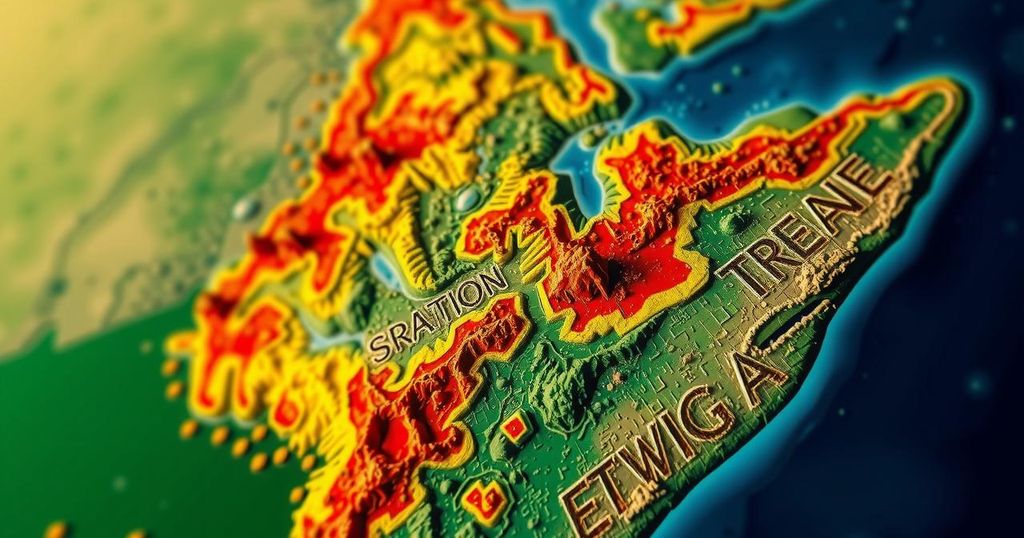Recent Seismic Activities in Awash Region: An Overview and Response

Recent earthquakes in the Awash region, including a notable 4.6 magnitude quake yesterday evening, have raised concerns among residents in Addis Ababa. The area has reported a series of tremors, attributed to tectonic activity related to the East African Rift. Experts emphasize the importance of ongoing monitoring and public preparedness in light of the increased seismic activity, while indicating that current magnitudes do not pose immediate risks to safety.
On the evening of October 23, 2024, the Awash region experienced its second earthquake of the day, registering a magnitude of 4.6 on the Richter scale at 6:20 p.m., as reported by the U.S. Geological Survey. This seismic event was felt by residents as far away as Addis Ababa, raising heightened concerns regarding the recent pattern of earthquakes in the area. The Awash Fentale region has recorded a total of five earthquakes in recent days, prompting alarm among local inhabitants and the issuance of precautionary messages from relevant authorities. In a statement, the Geophysics, Space Science, and Astronomy Institute at Addis Ababa University confirmed a series of seismic activities of varying magnitudes within the Awash Fentale district. Professor Atalay Ayele, the Head of the Sociology Department at the same institution, further elaborated on the seismic events, noting that the strongest tremor reached a magnitude of 4.6 at precisely 6:13 p.m. While the tremors were indeed felt across different locations in Addis Ababa, Professor Ayele reassured the public that the lower magnitudes of these earthquakes currently pose no significant risk to residents. Professor Ayele identified the Awash Fentale region as a tectonically active area, situated near the East African Rift, where tectonic plates are known to diverge gradually. As a result, frequent, low-magnitude earthquakes are a common occurrence, typically regarded as non-threatening, although capable of causing unease among those unfamiliar with such natural activities. He emphasized the critical need for continuous monitoring to detect any escalations in seismic frequency or intensity. Additionally, Gebretsadiq, the Head of the Geology Department at Samara University, shared insights regarding the earthquakes. In conversation with Fana Broadcasting Corporation (FBC), he suggested that the recent seismic tremors are likely associated with the movement of molten rock, or magma, beneath the Earth’s crust, which generates pressure and leads to fracturing within surrounding rock formations. Gebretsadiq noted that the geological characteristics of the region, particularly its volcanic history, increase the likelihood of such seismic activities. Despite the uptick in earthquakes, Gebretsadiq remarked on the challenges of predicting their duration and recurrence, attributing this difficulty to the complex interplay of geological forces. He underscored the importance of preparing for potential future seismic incidents through public awareness campaigns aimed at educating residents on earthquake preparedness and safety protocols. Furthermore, he highlighted the necessity for ongoing research to enhance understanding of the area’s seismic patterns, which could inform preventative measures for the community. In light of these developments, Ethiopian governmental and geological entities have collaborated to maintain vigilant monitoring of the situation. Various agencies are actively disseminating essential information and guidance to ensure public safety. Residents are encouraged to familiarize themselves with emergency response plans and exercise caution, as even minor earthquakes have the potential to induce structural damage or contribute to larger seismic incidents. Experts advocate for preparedness among residents in both Addis Ababa and surrounding areas in anticipation of potential future earthquakes, regardless of their magnitude. Simple safety measures—such as securing heavy furniture, designating safe zones for shelter during quakes, and assembling basic emergency kits—can significantly enhance community resilience against seismic threats. The recent earthquakes in the Awash Fentale region have highlighted the area’s susceptibility to tectonic activity. Geologists remain focused on examining the local fault lines and volcanic structures to better evaluate the risks associated with residing in a seismically active zone. Although there is currently no apparent imminent danger, the frequency of contractions serves as a valuable reminder of the necessity for preparedness and informed action. Both local and international geologists plan to engage in further research to assess the long-term ramifications of these seismic movements on nearby communities. Until such studies yield more substantial data, public vigilance and adherence to safety guidelines will remain paramount among residents throughout the region.
The Awash region, located within a tectonically active area near the East African Rift, has experienced an increase in seismic activity, including multiple recent earthquakes. Understanding the geological context of the region is crucial for interpreting these events. The East African Rift is characterized by the gradual divergence of tectonic plates, leading to frequent low-magnitude earthquakes. While these seismic occurrences are generally not deemed hazardous, they can nonetheless cause concern among the population. Awareness and preparedness measures are essential to mitigate risks associated with such natural events.
The occurrence of recent earthquakes in the Awash region serves to remind residents of the inherent seismic risks associated with living near tectonic fault lines. Continuous monitoring and research efforts are instrumental in understanding these risks better and implementing necessary safety protocols. While current seismic activity has not yet presented a significant threat, the local populace is urged to remain vigilant, prepared, and informed about earthquake safety measures as they navigate life in a tectonically active zone.
Original Source: addisinsight.net







